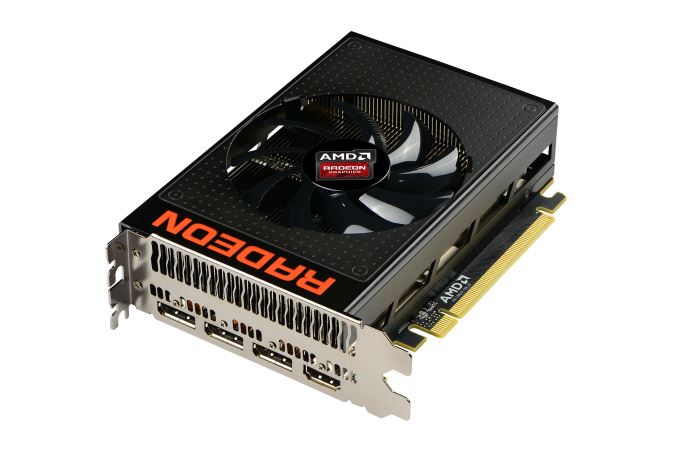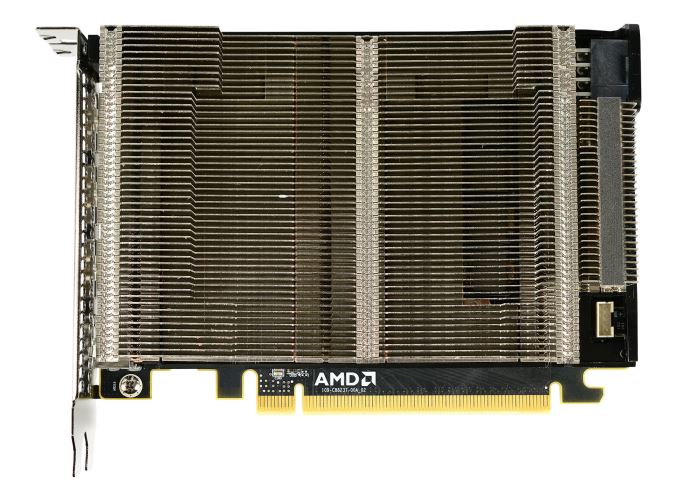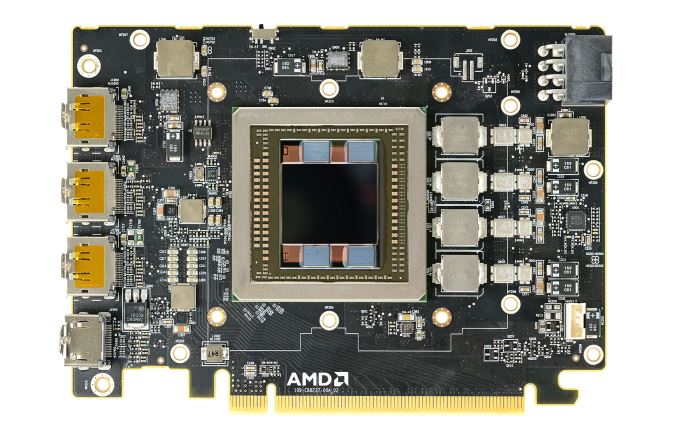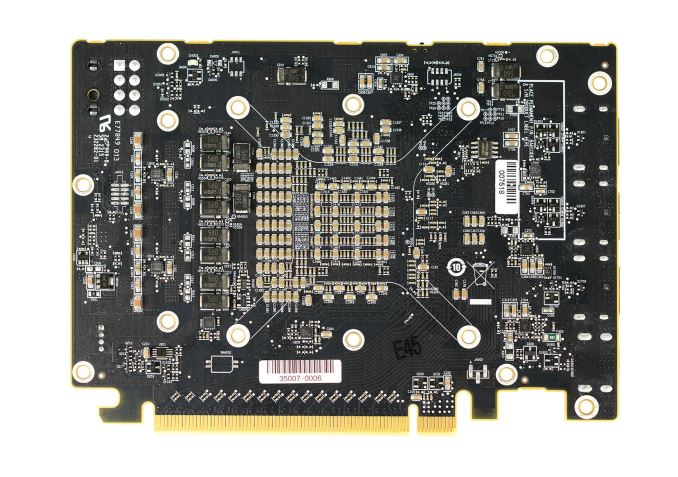The AMD Radeon R9 Nano Review: The Power of Size
by Ryan Smith on September 10, 2015 8:00 AM ESTMeet The Radeon R9 Nano
6 inch video cards are by no means a new thing in the GPU space, however these are traditionally lower-end products that need neither a large cooler nor an extensive power delivery system. As a result the R9 Nano is something of an interesting aberration, packing a lot more power and a lot more technology into half a foot of video card than what we normally see.
Starting as always from the top, the R9 Nano measures 6” long, which is actually a bit shorter than the full length the Mini-ITX standard allows. Responsibility for cooling the card falls to the R9 Nano’s new open air cooler, an aggressive design that has been specifically tailored to allow the card to effectively dissipate 175W of heat in such a small space.
The overall design of the R9 Nano’s cooler is best described as a combination open-air and half-blower hybrid. The design is technically open-air, employing a single axial fan to cool the card. However with only a single fan AMD has been able to align the heatsink fins horizontally and then place the fan in the center of the heatsink. The end result is that roughly half of the heat produced by the card is vented outside of the case, similar to a full blower, while the other half of the heat is vented back into the case. This reduces (though doesn’t eliminate) the amount of hot air being recycled by the card.
The heatsink itself is composed of aluminum and runs virtually the entire length of the card. This is technical a two-piece heatsink, with the primary heatsink composing the bulk of the card, while a much smaller secondary heatsink it found towards the far end of the card and mounted on top of a heatpipe.
Drilling down, we find that the primary heatsink is fed by a combination vapor chamber and heatpipe design. A copper vapor chamber serves to draw heat away from the Fiji GPU and HBM stacks, and then heatpipes are used to better distribute heat to the rest of the heatsink. The use of a vapor chamber in the R9 Nano makes a lot of sense given the fact that vapor chambers are traditionally the most efficient heatsink base type, however the R9 Nano is also unique in that we typically don’t see vapor chambers and heatpipes used together. Other designs such as the high-end GeForce series use a single large vapor chamber across the entire heatsink base, so among reference cards at least the R9 Nano stands alone in this respect. In this case given AMD’s design goals for size and noise, a vapor chamber will play a big part in helping the small card effectively and quietly dissipate 175W.
As for the physical PCB itself, as we can see AMD made it a relatively packed card in order to get the R9 Nano down to 6 inches. Compared to the R9 Fury X reference board, the biggest change here is that AMD has removed a fair bit of power circuitry to save space. By our count there are 4 VRM phases to feed the Fiji GPU, as opposed to the 6 found on R9 Fury X. Power delivery is handled by a single 8-pin PCIe power socket, which is becoming increasingly common, replacing the 2x 6-pin setup for 150W-225W cards.
Meanwhile to further shrink the overall PCB footprint, AMD has moved some of the remaining power delivery circuitry to the back of the card. The front of the card still contains the inductors and heat-sensitive MOSFETs, while a number of capacitors are on the rear of the card (and is why you won’t find a backplate).
Finally, for display I/O R9 Nano is unchanged from R9 Fury X. This means we’re looking at a DVI-free design, with 3x DisplayPort 1.2 and 1x HDMI 1.4 port all along a single row of the I/O bracket. Buyers looking to put together HTPCs will want to be especially mindful of the HDMI 1.4 port; while it's not necessarily a deal-breaker, it does mean that the R9 Nano can't fully drive 4Kp60 TVs, which are slowly but surely becoming more common.
Overall AMD is rather confident in their design for the R9 Nano. The heatsink is built to efficiently dissipate more heat than the 175W the card requires (despite the small size), and as a result we never see the R9 Nano thermally throttle under normal operation. The card’s thermal throttle point is 85C, and in our testing the card never passed 75C, exactly as AMD promised us. What ends up limiting the R9 Nano’s performance then is exactly as expected: the power throttling.
















284 Comments
View All Comments
HOOfan 1 - Thursday, September 10, 2015 - link
Plenty of SFF cases fit full size cards now, unless you just have money burning holes in your pocket, why not buy one of those and get a regular non-X Fury or a 390X?przemo_li - Thursday, September 10, 2015 - link
ROTFL390X & 980 are TWICE as long.
That is SFF. Yeah, right. I will write SFF on my ITX tower. It will be so cool :P
trentchau - Thursday, September 10, 2015 - link
My Obsidian 250D is considered SFF (close to not being one) and it has a 980Ti in it. Why the laughter?HOOfan 1 - Thursday, September 10, 2015 - link
Fractal Node 202 will fit a GTX 980...are you going to tell me that is not small form factor?ingwe - Thursday, September 10, 2015 - link
For me there is a difference between a truly small form factor design and one that is "small form factor" but built to house a card twice as large as this. I am not saying this is an important distinction to everyone, but it is one that I would make. There is just a lot of size variability in mini-ITX cases.Your question though does really illustrate how much of a niche product this is though. You literally need to be going for the smallest package possible while retaining most of the performance--and not care about cost. It is an interesting product, but it is a mixed bag like the interview says.
tviceman - Thursday, September 10, 2015 - link
Clearly the Nano is a more interesting card to review but the obvious elephant in the room here is that Anandtech have completely dropped the ball on the last two major Nvidia releases (gtx 960 and gtx 950). Not only that, but you were also late with the Fury X review (being bed ridden can be a valid excuse but when deadlines are continually missed excuses run dry).Ryan you have great analysis, fair reviews, and strong writing. You've also had days, weeks (and months) to get reviews out (and on time) with the above mentioned cards and have failed to do so. You obviously need more help with reviews.
Oxford Guy - Thursday, September 10, 2015 - link
The 960 wasn't reviewed, most likely, because it was turkey.Gigaplex - Thursday, September 10, 2015 - link
How am I supposed to know it was turkey without either reading the review that doesn't exist, or buying one myself and being seriously disappointed? You don't just skip reviewing products that aren't very good, otherwise that defeats the point in reviews.K_Space - Friday, September 11, 2015 - link
@GigaplexI think Of is insinuating that Anandtech would not review a product that defaces nVidia (though I disagree). Getting the Nano review as a priority plus being chief editor (who probably proof reads other reviews), add in various administritive duties and it all takes its toll. The annual call up for reviewers has gone out recently; I think Anandtech made it clear enough they would love a helping hand in getting timely reviews... On time.
K_Space - Friday, September 11, 2015 - link
OG*